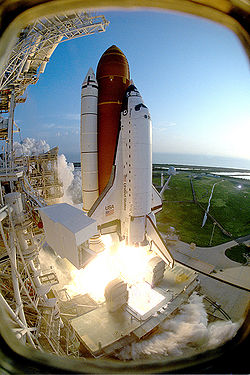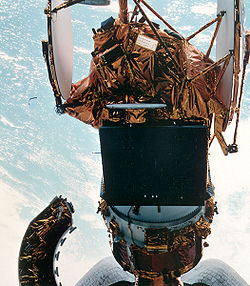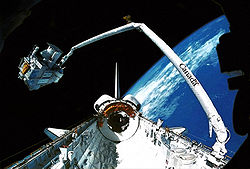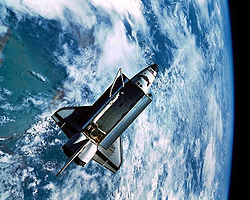
STS-51
Encyclopedia
STS-51 was a Space Shuttle
Discovery
mission that launched the Advanced Communications Technology Satellite ACTS in September 1993. The flight also featured the deployment and retrieval of the SPAS-ORFEUS satellite and its IMAX camera, which captured spectacular footage of Discovery in space. A spacewalk was also performed during the mission to evaluate tools and techniques for the STS-61
Hubble Space Telescope
servicing mission later that year. STS-51 was the first shuttle mission to fly a GPS receiver, a Trimble TANS Quadrex. It was mounted in an overhead window where limited field of view
and signal attenuation from the glass severely impacted receiver performance. (Full triple-redundant
3-string GPS would not happen until 14 years later with STS-118
.)
 STS-51 was notable for having been scrubbed three times on the launchpad, each time after the crew had boarded the spacecraft:
STS-51 was notable for having been scrubbed three times on the launchpad, each time after the crew had boarded the spacecraft:

 The Advanced Communications Technology Satellite was deployed on flight day 1. This satellite served as a test bed for advanced experimental communications satellite concepts and technology. Its Transfer Orbit Stage
The Advanced Communications Technology Satellite was deployed on flight day 1. This satellite served as a test bed for advanced experimental communications satellite concepts and technology. Its Transfer Orbit Stage
(TOS) upper stage fired on time 45 minutes after deployment and boosted the satellite to geosynchronous altitude
on the first day of the mission.
The first attempt to deploy ACTS was delayed by the crew when two-way communications were lost with Mission Control about 30 minutes before the deploy time. Flight controllers could receive telemetry
and voice communications from Discovery, however the crew could not receive communications from the ground. The crew waived off the 2:43 pm CDT deploy when they did not receive a "go" from Mission Control as called for in preflight plans made for just such an occurrence.
After the waive off of deploy, the crew changed the shuttle's S-Band communications system to a lower frequency and restored two-way communications with the ground. The two-way communications had been lost for a total of about 45 minutes. After consulting the crew, flight controllers began immediately planning for the second, and ultimately successful deploy.
During the deployment on 12 September, two Super*Zip explosive cords in the Airborne Support Equipment cradle (ASE) designed to release the spacecraft ,one primary and the other a backup, simultaneously detonated. This caused minor tears in two dozen insulation blankets mounted on the bulkhead between the payload bay and the AFT near the #3 APU. The ASE ring holding the TOS was damaged as well, and ejected debris was visible as the stack moved away from the orbiter.
The Advanced Communications Technology Satellite (ACTS), a significant activity of the NASA Space Communications Program, provided for the development and flight test of high-risk, advanced communications satellite technology. Using multiple spot beam antennas and advanced on-board switching and processing systems, ACTS pioneered new initiatives in communications satellite technology. NASA Glenn Research Center was responsible for the development, management, and operation of ACTS as part of a long legacy of experimental communications satellites.
After fulfilling its original mission, the spacecraft continued operations through a partnership between the space agency and a nonprofit consortium. It was shut down 28 April 2004 after funding dried up. The satellite was put into a flat spin with its solar array edges facing the sun, preventing it from ever being restarted. The spacecraft was moved to its final resting place at 105.2 degrees west longitude – where it poses minimal risk to other satellites – after NASA concluded in 2000 that it probably lacked the fuel to move to a higher graveyard orbit. Nevertheless, ACTS should not re-enter the atmosphere for thousands of years, according to Richard Krawczyk, the ACTS operations manager at Glenn Research Center.
 Another payload on this mission was the Orbiting Retrievable Far and Extreme Ultraviolet Spectrometer (ORFEUS) telescope mounted on the Shuttle Pallet Satellite (SPAS) payload carrier. ORFEUS was designed to provide information on how star
Another payload on this mission was the Orbiting Retrievable Far and Extreme Ultraviolet Spectrometer (ORFEUS) telescope mounted on the Shuttle Pallet Satellite (SPAS) payload carrier. ORFEUS was designed to provide information on how star
s are born and how they die, while studying gaseous interstellar cloud
s. Also in the cargo bay was the Limited Duration Space Environment Candidate Materials Exposure (LDCE) experiment.
MBB (Messerschmitt-Bölkow-Blohm
) began development of the SPAS carrier (flown previously on STS-7
, STS-41B, and STS-39
) in 1986 into a free-flying astronomical platform. The DARA
/NASA agreement called for four co-operative science missions, with DARA providing the satellite, NASA the Shuttle launch and deployment/retrieval services, and the two parties sharing the science instruments. NASA provided the Shuttle free of charge, in return for access to data and the inclusion of US experiments. ORFEUS, the Orbiting and Retrievable Far/Extreme UV Spectrometer, designed to measure radiation between 400–1,280 angstroms, was released at 14.06 GMT 13 September 1993, and was retrieved at 11.50 GMT 19 September 1993. Science contributions came from the University of Tübingen, Sternwarte Heidelberg, University of Berkeley and Princeton University (IMPAS). ORFEUS' telescope was fabricated by Kayser-Threde
in Germany; France's REOSC provided the 1 m f/2.5 mirror. The separate 950-1,150 Å IMAPS Interstellar Medium Absorption Profile Spectrograph added to the observations of hot galactic objects and the interstellar medium at high spectral resolution (240,000). Other payloads were DLR's Surface Effective Sample Monitor and Canada's IMAX Cargo Bay Camera, which was used to film Discovery in orbit for the IMAX film Destiny in Space
. A portion of this footage was also included in Space Station 3D
. This was the fourth flight of the SPAS platform, of a total of seven during the space shuttle program. The SPAS-ORFEUS version was reflown on mission STS-80
in 1996.
and Carl Walz performed an EVA
designed to evaluate tools, tethers and a foot restraint platform. Their findings reassured the designers and planners of the Hubble Space Telescope
servicing flight that their preparations were sound. This was the third and final shuttle mission to include a preparatory EVA in response to the weaknessness in EVA training exposed by the STS-49
mission. The new equipment tested during the extensive spacewalk would later be required for the December 1993 Hubble Space Telescope
servicing mission, and was only part of the objectives of the spacewalk, with Newman and Walz fulfilling the other goals as they explained at length to Mission Control the differences they perceived between work in orbit and ground training. The two EVA crewmen were ahead of schedule much of the day, and completed more tasks than originally planned. As the two astronauts were cleaning up, a balky tool box lid slowed them down when they had to pry it free and close it for Discovery’s trip home. The toolbox lid stretched the spacewalk by about 45 minutes over what had been planned, with Newman and Walz logging a total seven hours, five minutes and 28 seconds of time outside of the vehicle. This was the 112th EVA performed in the history of human spaceflight.
 In-cabin payloads included the Air Force Maui Optical Site (AMOS) Auroral Photography Experiment-B (APE-B), Commercial Protein Crystal Growth (CPCG), Chromosome and Plant Cell Division in Space (CHROMEX), High Resolution Shuttle Glow Spectroscopy-A (HRSGS-A), IMAX, Investigations into Polymer Membrane Processing (IPMP) and the Radiation Monitoring Equipment-III (RME-III) experiment. The Investigation into Polymer Membrane Processing, or IPMP, is designed to research the mixing of various solvent systems in the absence of convection found on Earth in hopes of controlling the porosity of various polymer
In-cabin payloads included the Air Force Maui Optical Site (AMOS) Auroral Photography Experiment-B (APE-B), Commercial Protein Crystal Growth (CPCG), Chromosome and Plant Cell Division in Space (CHROMEX), High Resolution Shuttle Glow Spectroscopy-A (HRSGS-A), IMAX, Investigations into Polymer Membrane Processing (IPMP) and the Radiation Monitoring Equipment-III (RME-III) experiment. The Investigation into Polymer Membrane Processing, or IPMP, is designed to research the mixing of various solvent systems in the absence of convection found on Earth in hopes of controlling the porosity of various polymer
membranes. RME measures gamma ray, electron, neutron and proton radiation levels in the crew cabin throughout the flight.
Onboard, Mission Specialist Jim Newman donned a special visor
to perform a medical experiment testing vision in weightlessness
as part of investigations into how vision compensates for the inner ear's lack of balance in space. Newman also successfully tested a Global Positioning System
receiver flying aboard Discovery as an evaluation of using such equipment to supplement the shuttle's navigation. Also, in a precursor of space station operations, one of Discovery’s fuel cell
s was turned off and restarted.
In another medical evaluation, Commander Frank Culbertson and Mission Specialist Dan Bursch rode a stationary bike on Discovery’s lower deck as part of a continuing study of using exercise to counteract the effects of weightlessness on the body. The crew also powered up an experiment that looks at improving membrane filters in weightlessness and checked on another experiment that has been running well studying the effects of microgravity on plant cells.
Astronauts Carl Walz and Jim Newman operated the experiments designed to study the glowing effect, one a spectrometer
that records the effect on film in fine detail and another that records the effect on still photographs. The experiments are hoped to provide information about just what types of gases – in addition to atomic oxygen – create the glow. The information on kinds of gases in the extreme reaches of the atmosphere may be coupled with the materials exposure experiment in the cargo bay to assist with the design and construction of future spacecraft.
Space Shuttle
The Space Shuttle was a manned orbital rocket and spacecraft system operated by NASA on 135 missions from 1981 to 2011. The system combined rocket launch, orbital spacecraft, and re-entry spaceplane with modular add-ons...
Discovery
Space Shuttle Discovery
Space Shuttle Discovery is one of the retired orbiters of the Space Shuttle program of NASA, the space agency of the United States, and was operational from its maiden flight, STS-41-D on August 30, 1984, until its final landing during STS-133 on March 9, 2011...
mission that launched the Advanced Communications Technology Satellite ACTS in September 1993. The flight also featured the deployment and retrieval of the SPAS-ORFEUS satellite and its IMAX camera, which captured spectacular footage of Discovery in space. A spacewalk was also performed during the mission to evaluate tools and techniques for the STS-61
STS-61
STS-61 was the first Hubble Space Telescope servicing mission, and the fifth flight of the Space Shuttle Endeavour. The mission launched on 2 December 1993 from Kennedy Space Center in Florida. The mission restored the spaceborne observatory's vision, marred by spherical aberration, with the...
Hubble Space Telescope
Hubble Space Telescope
The Hubble Space Telescope is a space telescope that was carried into orbit by a Space Shuttle in 1990 and remains in operation. A 2.4 meter aperture telescope in low Earth orbit, Hubble's four main instruments observe in the near ultraviolet, visible, and near infrared...
servicing mission later that year. STS-51 was the first shuttle mission to fly a GPS receiver, a Trimble TANS Quadrex. It was mounted in an overhead window where limited field of view
Field of view
The field of view is the extent of the observable world that is seen at any given moment....
and signal attenuation from the glass severely impacted receiver performance. (Full triple-redundant
Redundancy (engineering)
In engineering, redundancy is the duplication of critical components or functions of a system with the intention of increasing reliability of the system, usually in the case of a backup or fail-safe....
3-string GPS would not happen until 14 years later with STS-118
STS-118
- Crew notes :Astronaut Clayton Anderson originally was slated to be launched to the ISS on this mission, but was moved to STS-117. His replacement was Alvin Drew....
.)
Crew
Mission parameters
- MassMassMass can be defined as a quantitive measure of the resistance an object has to change in its velocity.In physics, mass commonly refers to any of the following three properties of matter, which have been shown experimentally to be equivalent:...
:- Orbiter landing with payload: 92371 kilograms (203,643.2 lb)
- Payload: 18947 kilograms (41,771 lb)
- PerigeePerigeePerigee is the point at which an object makes its closest approach to the Earth.. Often the term is used in a broader sense to define the point in an orbit where the orbiting body is closest to the body it orbits. The opposite is the apogee, the farthest or highest point.The Greek prefix "peri"...
: 300 kilometres (186.4 mi) - Apogee: 308 kilometres (191.4 mi)
- InclinationInclinationInclination in general is the angle between a reference plane and another plane or axis of direction.-Orbits:The inclination is one of the six orbital parameters describing the shape and orientation of a celestial orbit...
: 28.45° - PeriodOrbital periodThe orbital period is the time taken for a given object to make one complete orbit about another object.When mentioned without further qualification in astronomy this refers to the sidereal period of an astronomical object, which is calculated with respect to the stars.There are several kinds of...
: 90.6 min
Space walks
- Newman and Walz – EVA 1
- EVA 1 Start: 16 September 1993 – 08:40 UTC
- EVA 1 End: 16 – 15 September:45 UTC
- Duration: 7 hours, 05 minutes
Launch Preparations

- On 17 July 1993, the launch was scrubbed on the pad due to a flaw in the pyrotechnic initiator controller that triggers the release of the solid rocket boosters from the mobile launcher platform.
- On 24 July 1993, problems with a hydraulic power unit in one of the solid rocket boosters caused another scrub on the pad. Because of the Perseid meteor shower, the next launch window did not open until the second week of August.
- On 12 August 1993, the count reached the T−3 second mark, at which point the Space Shuttle Main EngineSpace Shuttle main engineThe RS-25, otherwise known as the Space Shuttle Main Engine , is a reusable liquid-fuel rocket engine built by Pratt & Whitney Rocketdyne for the Space Shuttle, running on liquid hydrogen and oxygen. Each Space Shuttle was propelled by three SSMEs mated to one powerhead...
(SSMEs) had ignited. A shutdown was then triggered by faulty fuel flow sensors in one of the SSMEs.
- STS-51 successfully launched on 12 September 1993.
Advanced Communications Technology Satellite (ACTS)


Transfer orbit stage
The Transfer Orbit Stage was an upper stage developed by Martin Marietta for Orbital Sciences Corporation during the late 1980s and early 1990s. The TOS was designed to be a lower-cost alternative to Inertial Upper Stage and Centaur upper stages...
(TOS) upper stage fired on time 45 minutes after deployment and boosted the satellite to geosynchronous altitude
Geosynchronous orbit
A geosynchronous orbit is an orbit around the Earth with an orbital period that matches the Earth's sidereal rotation period...
on the first day of the mission.
The first attempt to deploy ACTS was delayed by the crew when two-way communications were lost with Mission Control about 30 minutes before the deploy time. Flight controllers could receive telemetry
Telemetry
Telemetry is a technology that allows measurements to be made at a distance, usually via radio wave transmission and reception of the information. The word is derived from Greek roots: tele = remote, and metron = measure...
and voice communications from Discovery, however the crew could not receive communications from the ground. The crew waived off the 2:43 pm CDT deploy when they did not receive a "go" from Mission Control as called for in preflight plans made for just such an occurrence.
After the waive off of deploy, the crew changed the shuttle's S-Band communications system to a lower frequency and restored two-way communications with the ground. The two-way communications had been lost for a total of about 45 minutes. After consulting the crew, flight controllers began immediately planning for the second, and ultimately successful deploy.
During the deployment on 12 September, two Super*Zip explosive cords in the Airborne Support Equipment cradle (ASE) designed to release the spacecraft ,one primary and the other a backup, simultaneously detonated. This caused minor tears in two dozen insulation blankets mounted on the bulkhead between the payload bay and the AFT near the #3 APU. The ASE ring holding the TOS was damaged as well, and ejected debris was visible as the stack moved away from the orbiter.
The Advanced Communications Technology Satellite (ACTS), a significant activity of the NASA Space Communications Program, provided for the development and flight test of high-risk, advanced communications satellite technology. Using multiple spot beam antennas and advanced on-board switching and processing systems, ACTS pioneered new initiatives in communications satellite technology. NASA Glenn Research Center was responsible for the development, management, and operation of ACTS as part of a long legacy of experimental communications satellites.
After fulfilling its original mission, the spacecraft continued operations through a partnership between the space agency and a nonprofit consortium. It was shut down 28 April 2004 after funding dried up. The satellite was put into a flat spin with its solar array edges facing the sun, preventing it from ever being restarted. The spacecraft was moved to its final resting place at 105.2 degrees west longitude – where it poses minimal risk to other satellites – after NASA concluded in 2000 that it probably lacked the fuel to move to a higher graveyard orbit. Nevertheless, ACTS should not re-enter the atmosphere for thousands of years, according to Richard Krawczyk, the ACTS operations manager at Glenn Research Center.
SPAS-ORFEUS

Star
A star is a massive, luminous sphere of plasma held together by gravity. At the end of its lifetime, a star can also contain a proportion of degenerate matter. The nearest star to Earth is the Sun, which is the source of most of the energy on Earth...
s are born and how they die, while studying gaseous interstellar cloud
Interstellar cloud
Interstellar cloud is the generic name given to an accumulation of gas, plasma and dust in our and other galaxies. Put differently, an interstellar cloud is a denser-than-average region of the interstellar medium. Depending on the density, size and temperature of a given cloud, the hydrogen in it...
s. Also in the cargo bay was the Limited Duration Space Environment Candidate Materials Exposure (LDCE) experiment.
MBB (Messerschmitt-Bölkow-Blohm
Messerschmitt-Bölkow-Blohm
Messerschmitt-Bölkow-Blohm was a German aerospace company formed as the result of several mergers in the late 1960s. Among its best-known products was the MBB Bo 105 light twin helicopter...
) began development of the SPAS carrier (flown previously on STS-7
STS-7
STS-7 was a NASA Space Shuttle mission, during which Space Shuttle Challenger deployed several satellites into orbit. The shuttle launched from Kennedy Space Center on 18 June 1983, and landed at Edwards Air Force Base on 24 June. STS-7 was the seventh shuttle mission, and was Challengers second...
, STS-41B, and STS-39
STS-39
-Mission parameters:*Mass:**Orbiter landing with payload: **Payload: *Perigee: *Apogee: *Inclination: 57.0°*Period: 89.6 min-Mission highlights:...
) in 1986 into a free-flying astronomical platform. The DARA
German Aerospace Center
The German Aerospace Center is the national centre for aerospace, energy and transportation research of the Federal Republic of Germany. It has multiple locations throughout Germany. Its headquarters are located in Cologne. It is engaged in a wide range of research and development projects in...
/NASA agreement called for four co-operative science missions, with DARA providing the satellite, NASA the Shuttle launch and deployment/retrieval services, and the two parties sharing the science instruments. NASA provided the Shuttle free of charge, in return for access to data and the inclusion of US experiments. ORFEUS, the Orbiting and Retrievable Far/Extreme UV Spectrometer, designed to measure radiation between 400–1,280 angstroms, was released at 14.06 GMT 13 September 1993, and was retrieved at 11.50 GMT 19 September 1993. Science contributions came from the University of Tübingen, Sternwarte Heidelberg, University of Berkeley and Princeton University (IMPAS). ORFEUS' telescope was fabricated by Kayser-Threde
Kayser-Threde
Kayser-Threde GmbH based in Munich, Germany is a systems house specializing in the design and development of high-technology solutions for astronautics, science and the industry...
in Germany; France's REOSC provided the 1 m f/2.5 mirror. The separate 950-1,150 Å IMAPS Interstellar Medium Absorption Profile Spectrograph added to the observations of hot galactic objects and the interstellar medium at high spectral resolution (240,000). Other payloads were DLR's Surface Effective Sample Monitor and Canada's IMAX Cargo Bay Camera, which was used to film Discovery in orbit for the IMAX film Destiny in Space
Destiny in Space
Destiny in Space is a 70mm American documentary film released to IMAX cinemas in 1994. The film is directed in part by Academy Award-winning sound designer Ben Burtt, and is narrated by Leonard Nimoy....
. A portion of this footage was also included in Space Station 3D
Space Station 3D
Space Station 3D is a 2002 documentary film about the International Space Station. It is the first IMAX 3D production filmed in space. It is narrated by Tom Cruise. The "flat" version was titled simply Space Station....
. This was the fourth flight of the SPAS platform, of a total of seven during the space shuttle program. The SPAS-ORFEUS version was reflown on mission STS-80
STS-80
-Mission parameters:* Mass: payload* Perigee: * Apogee: * Inclination: 28.5°* Period: 91.5 min-Mission highlights:* The mission deployed two satellites and successfully recovered them after they had performed their tasks....
in 1996.
EVA
On Thursday, 16 September 1993, spacewalkers Jim NewmanJames H. Newman
James Hansen Newman is an American physicist and a former NASA astronaut who flew on four Space Shuttle missions..- Personal data :...
and Carl Walz performed an EVA
Extra-vehicular activity
Extra-vehicular activity is work done by an astronaut away from the Earth, and outside of a spacecraft. The term most commonly applies to an EVA made outside a craft orbiting Earth , but also applies to an EVA made on the surface of the Moon...
designed to evaluate tools, tethers and a foot restraint platform. Their findings reassured the designers and planners of the Hubble Space Telescope
Hubble Space Telescope
The Hubble Space Telescope is a space telescope that was carried into orbit by a Space Shuttle in 1990 and remains in operation. A 2.4 meter aperture telescope in low Earth orbit, Hubble's four main instruments observe in the near ultraviolet, visible, and near infrared...
servicing flight that their preparations were sound. This was the third and final shuttle mission to include a preparatory EVA in response to the weaknessness in EVA training exposed by the STS-49
STS-49
-Mission parameters:*Mass:**Orbiter landing with payload: **Payload: *Perigee: *Apogee: *Inclination: 28.35°*Period: 90.6 min-Space walks:* Thuot and Hieb – EVA 1*EVA 1 Start: 10 May 1992 – 20:40 UTC...
mission. The new equipment tested during the extensive spacewalk would later be required for the December 1993 Hubble Space Telescope
Hubble Space Telescope
The Hubble Space Telescope is a space telescope that was carried into orbit by a Space Shuttle in 1990 and remains in operation. A 2.4 meter aperture telescope in low Earth orbit, Hubble's four main instruments observe in the near ultraviolet, visible, and near infrared...
servicing mission, and was only part of the objectives of the spacewalk, with Newman and Walz fulfilling the other goals as they explained at length to Mission Control the differences they perceived between work in orbit and ground training. The two EVA crewmen were ahead of schedule much of the day, and completed more tasks than originally planned. As the two astronauts were cleaning up, a balky tool box lid slowed them down when they had to pry it free and close it for Discovery’s trip home. The toolbox lid stretched the spacewalk by about 45 minutes over what had been planned, with Newman and Walz logging a total seven hours, five minutes and 28 seconds of time outside of the vehicle. This was the 112th EVA performed in the history of human spaceflight.
Secondary Experiments

Polymer
A polymer is a large molecule composed of repeating structural units. These subunits are typically connected by covalent chemical bonds...
membranes. RME measures gamma ray, electron, neutron and proton radiation levels in the crew cabin throughout the flight.
Onboard, Mission Specialist Jim Newman donned a special visor
Visor
A visor is a surface that protects the eyes, such as shading them from the sun or other bright light or protecting them from objects....
to perform a medical experiment testing vision in weightlessness
Weightlessness
Weightlessness is the condition that exists for an object or person when they experience little or no acceleration except the acceleration that defines their inertial trajectory, or the trajectory of pure free-fall...
as part of investigations into how vision compensates for the inner ear's lack of balance in space. Newman also successfully tested a Global Positioning System
Global Positioning System
The Global Positioning System is a space-based global navigation satellite system that provides location and time information in all weather, anywhere on or near the Earth, where there is an unobstructed line of sight to four or more GPS satellites...
receiver flying aboard Discovery as an evaluation of using such equipment to supplement the shuttle's navigation. Also, in a precursor of space station operations, one of Discovery’s fuel cell
Fuel cell
A fuel cell is a device that converts the chemical energy from a fuel into electricity through a chemical reaction with oxygen or another oxidizing agent. Hydrogen is the most common fuel, but hydrocarbons such as natural gas and alcohols like methanol are sometimes used...
s was turned off and restarted.
In another medical evaluation, Commander Frank Culbertson and Mission Specialist Dan Bursch rode a stationary bike on Discovery’s lower deck as part of a continuing study of using exercise to counteract the effects of weightlessness on the body. The crew also powered up an experiment that looks at improving membrane filters in weightlessness and checked on another experiment that has been running well studying the effects of microgravity on plant cells.
Astronauts Carl Walz and Jim Newman operated the experiments designed to study the glowing effect, one a spectrometer
Spectrometer
A spectrometer is an instrument used to measure properties of light over a specific portion of the electromagnetic spectrum, typically used in spectroscopic analysis to identify materials. The variable measured is most often the light's intensity but could also, for instance, be the polarization...
that records the effect on film in fine detail and another that records the effect on still photographs. The experiments are hoped to provide information about just what types of gases – in addition to atomic oxygen – create the glow. The information on kinds of gases in the extreme reaches of the atmosphere may be coupled with the materials exposure experiment in the cargo bay to assist with the design and construction of future spacecraft.
Mission insignia
The five white stars and one yellow star of the insignia symbolize the flight's numerical designation in the Space Transportation System's mission sequence. The insignia also depicts the triangular SPAS-ORFEUS on the right.See also
- Space scienceSpace scienceThe term space science may mean:* The study of issues specifically related to space travel and space exploration, including space medicine.* Science performed in outer space ....
- Space shuttleSpace ShuttleThe Space Shuttle was a manned orbital rocket and spacecraft system operated by NASA on 135 missions from 1981 to 2011. The system combined rocket launch, orbital spacecraft, and re-entry spaceplane with modular add-ons...
- List of space shuttle missions
- List of human spaceflights chronologically

